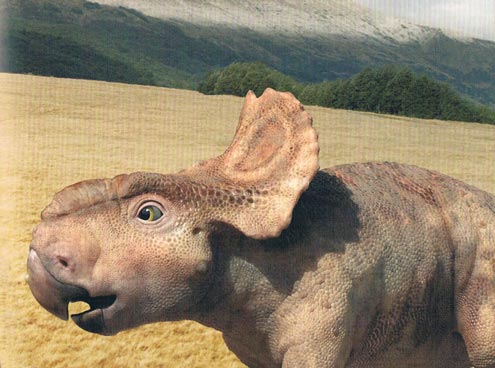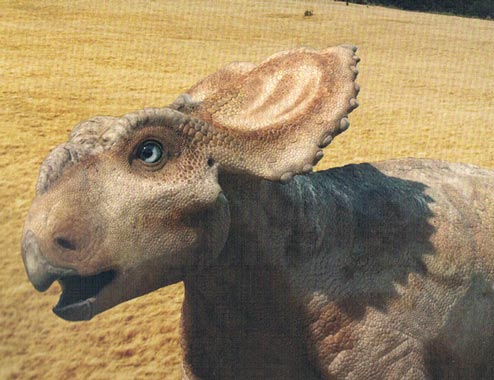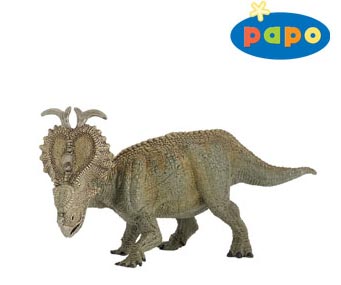New Walking with Dinosaurs in 3-D Reviewed
“Patchi” and Friends in a Coming of Age Saga Set in the Cretaceous
Just in time for Christmas comes the release of the long-awaited “Walking with Dinosaurs in 3-D” a film that features an array of Late Cretaceous prehistoric animals (dinosaurs mostly) with the narrator of our story being Alex an Alexornis, an ancient bird* who via a segue that manages to link the present day to the Late Cretaceous of North America, is introduced as our guide to the adventures of a horned dinosaur called “Patchi”.
“Patchi” the Pachyrhinosaurus
The fact that there were many different types of prehistoric bird around, is just one of the snippets of information that can be gleaned from seeing the film. The movie is a collaboration between BBC Earth and 20th Century Fox and although it shares the same title as the BBC’s ground breaking television series “Walking with Dinosaurs” that first aired back in 1999, this is a very different “beastie”.
In the six part BBC television series, each half hour episode was narrated by Sir Kenneth Branagh, (although he wasn’t a Knight at the time), these programmes combined the BBC’s tradition for making excellent nature documentaries with ground-breaking computer generated special effects. Back in 1999, seeing a dinosaur come to life on the screen or to view a prehistoric habitat was something very memorable. After all, Steven Spielberg’s Jurassic Park may have resurrected the Dinosauria and shown for the first time how powerful CGI could be, but the back drops to the fearsome dinosaurs were all modern day locations.
Walking with Dinosaurs
In the BBC television series, the programmes managed to create the effect that here was an actual nature documentary shot in the Mesozoic.
Much the same look is achieved in this cinema offering, the background scenery (the location shots were taken in New Zealand and Alaska) is breath taking, however, fourteen years on, we are so used to CGI that the effects seem to have lost some of their impact. With so many fantasy films, computer programmes and in the Youtube generation, perhaps our senses have been dulled somewhat.
Pachyrhinosaurus Adventures
The story seems to follow the typical plot of a film aimed very much at young viewers. An underdog, the runt of the litter gets into all sorts of scrapes and adventures before finally growing up to become a hero. There is even a love interest, yes, romance in a film all about dinosaurs, but more of that later. “Patchi” and his big brother (“Scowler”) are pachyrhinosaurs, horned dinosaurs that are distantly related to the more famous Triceratops, but lack the impressive nose and brow horns. Thanks to an encounter with a speedy, carnivorous Troodon, “Patchi” gains a hole in his frill, which is very distinctive, a useful cinematic device to make him distinguishable from all the other pachyrhinosaurs in the herd scenes, helpful for very young viewers so that they can follow the story line more easily.
The film has been described as “infotainment”, as periodically the action is frozen and the Latin names of the prehistoric creatures and other supporting data is displayed on the screen, perhaps this is a nod to the grown-ups who can take solace in the fact that this film might have some educational value. The film is very reminiscent of Disney’s offering “Dinosaur” (released in 2000), the dinosaurs even have American accents – apt, as the action does take place in North America.
The characters depicted in the film may be largely reptilian (there are mammals and birds too), but all of them have been anthropomorphosised and often they come across as mere caricatures although it is hard to consider how human-like, a two tonne, extinct ceratopsian might possibly have been. The story jogs along at a merry pace and covers ten years in the life of the herd, time enough for “Patchi” to prove that brains are sometimes better than brawn.
The dialogue can be a bit grating at times, there are all sorts of modern-day references, (as if dinosaurs, knew anything about chew toys or ninjas) and the film makers seemed to be passionately concerned with ensuring that there must dialogue for every frame of the film. For animals capable of only screeches, bellows and roars, the dinosaurs certainly do talk a lot.
“Patchi” – The Runt of a Litter of Pachyrhinosaurs
Gorgosaurus
“Patchi” with his brown eyes meets “Juniper” a female Pachyrhinosaurus from a neighbouring herd (she has blue eyes), eye colour in ceratopsians is something that we at Everything Dinosaur haven’t actually considered. “Patchi” and his brother get separated from their herd after a forest fire, they join up with another group of migrating pachyrhinosaurs and “Patchi” is thrown together with “Juniper”. When these young dinosaurs get lost again, thanks to an attack by a gang of Gorgosaurus (tyrannosaurids similar to T. rex but smaller and lighter), another set of adventures begins and the love interest with “Patchi” falling head over his ceratopsian heels for “Juniper”.
The three animals have to find their own way to the winter feeding grounds. This part of the film has echoes of the “Incredible Journey” another Disney offering about three pets trying to make it back to their owners. The original “Incredible Journey” came out in 1963 with a re-make thirty years later starring the voice over talents of the likes of Michael J. Fox, Sally Field and Don Ameche. From this perspective dogs and cats seem easier to anthropomorphosise than dinosaurs.
The film carries a “U” certificate, although parents of particularly young children will need to be mindful that this film does depict predators attacking, it is very much a case of nature “red in tooth and claw”. At eighty-seven minutes, the film is fractionally shorter than the “Walking with Dinosaurs” stage show, but unlike the live event there is no fifteen minute interval. To the delight of the young viewers the humour has lots of scatological references, our hero “Patchi” literally gets “dumped on from a great height” at one point.
No doubt the film will do very well which then could bring about the prospect of a sequel, or indeed an entire franchise of these dino-inspired, infotainments. For us, we can always put on one of the BBC “Walking with Dinosaurs” episodes from that ground-breaking television series, which in our view are far superior.
Blue-Eyed “Juniper” – Romance in the Late Cretaceous?
Note about Prehistoric Birds from the Late Cretaceous
*Alexornis is a member of the Enantiornithines, a clade of prehistoric birds that were relatively abundant towards the end of the Age of Dinosaurs. Something like fifty different species of Enantiornithines have been named so far.
A Model of an Adult Pachyrhinosaurus (P. canadensis)
Picture credit: Everything Dinosaur
To view the model range that features the Pachyrhinosaurus replica shown: Papo Models and Prehistoric Animals.
The Beasts of the Mesozoic model range (articulated figures) also includes a replica of a Pachyrhinosaurus. To view this excellent range: Beasts of the Mesozoic Prehistoric Animal Models.




